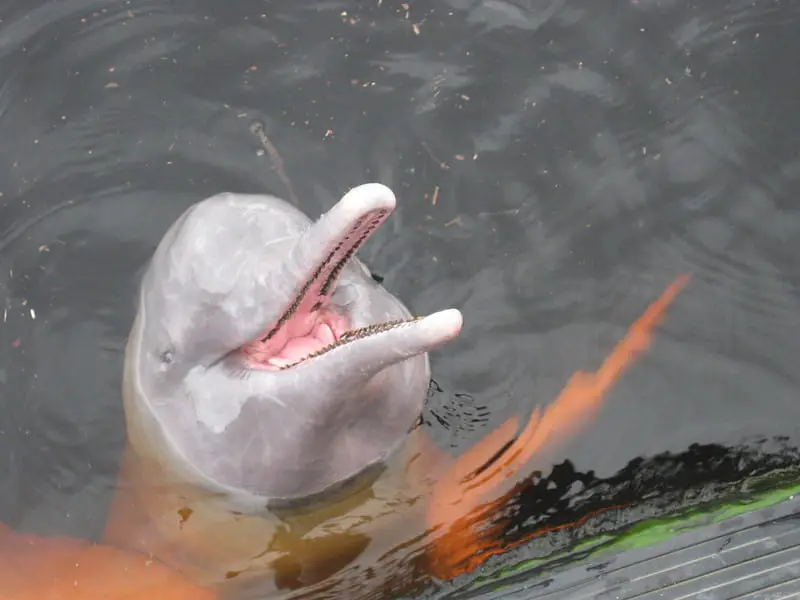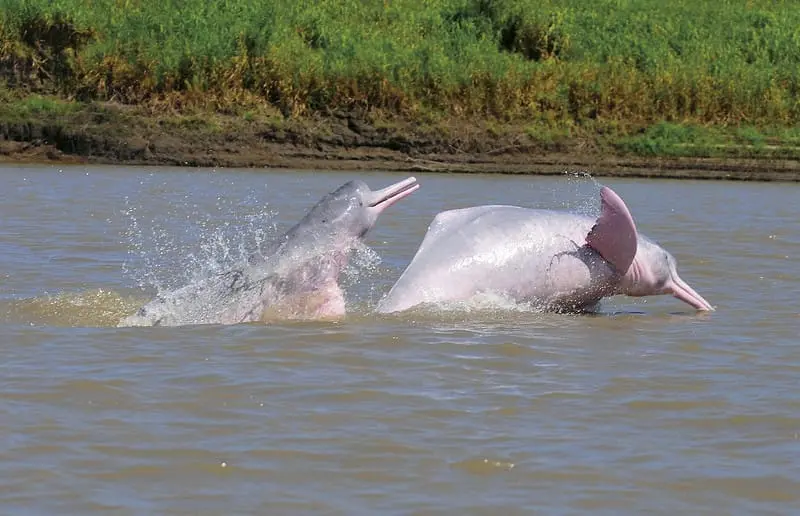The Life of the River Dolphins
The river dolphin are a group of dolphins adapted to life in fresh water. The difference between saltwater dolphins and river dolphins is due to the fact that saltwater dolphins belong to the Delphinidae family, while river dolphins belong to the Iniidae family. Both are part of the cetacean group, which also includes whales — specifically toothed whales such as the sperm whale and the orca.
Unlike dolphins, river dolphins are usually solitary (although they are seen in small groups on some occasions) they are slow and rarely jump. Among all dolphins and toothed whales, river dolphins have the broadest diet, feeding on turtles and crabs, in addition to their main food, which is fish. Also, because they have adapted to live in warm, shallow waters, they have very little fat — compared to their cousins who need a fat-rich body to keep warm in cold, deep waters.
Although there is a debate about the classification of species and subspecies, there are 2 species of river dolphins that are distributed in the Amazon and Solimões river basins — the Amazon River dolphin (I. geoffrensis) and in the Bolivian sub-basin — the Bolivian river dolphin (I. boliviensis), discovered only in 2014. Two other species or subspecies are also targets of debate over their classification, the I. araguaiesis and the I. humboldtiana, and more studies need to be conducted for a definitive answer.
The species are very similar, with some subtle differences in color, size and some physical characteristics. Therefore, they are not so easy to be noticed by someone who is not a specialist.

In addition to being the largest dolphin species in Brazil, the Amazon River dolphin has the largest geographic distribution. It is distributed over an area of about 7 million square kilometers and can be found in Bolivia, Peru, Brazil, Colombia, Ecuador and Venezuela. It occurs in all the tributaries of the Amazon, Orinoco and Araguaia-Tocantins rivers.
Although it is called the pink river dolphin in Brazil, only the adults have a partial pink coloration — the juveniles are usually dark gray and the males are pinker than the females. The coloration can also vary depending on the turbidity of the water and the location.
Males can be up to 2.5 m (8 ft) long and weigh up to 185 kg (407 lb). Females, on the other hand, are usually a bit smaller at 2.15 m (7 ft) and 150 kg (330 lb). Females only have one calf every two or three years. The gestation period is between 10 and 11 months, and the calf does not reach sexual maturity until it is 6 or 7 years old. In other words, river dolphins have a long gestation period and each female has only a few calves in her lifetime. Like other cetaceans, river dolphins are mammals, so the young feed on their mother’s milk for about 1 year.
The echolocation of river dolphins
Like dolphins and toothed whales, river dolphins have a melon-like prominence on their heads that is an organ responsible for their sonar communication and echolocation. It is used to help them hunt by locating and providing an idea about the distance, shape, and size of the target.
Amazonian rivers are usually very murky — so is likely that in order to swim and find prey the Amazon River dolphin is guided much more by its echolocation than by its eyesight. However, echolocation can result in too many objects to track in shallow water and flooded forests. For each signal produced, many echoes are likely to return to the animal, making it difficult to distinguish the target. This may be why it produces weaker and more frequent signals than dolphins. By sending out lower amplitude signals, only nearby objects are detected, making them easier to identify.

Threats to the species
River dolphins are indicators of the health of the rivers in which they live: if the population in a particular location is thriving, it means that the overall health of the local ecosystem is also thriving. But if the population is declining, it is considered a warning sign. Despite this, they are one of the most endangered animals in the world.
Although hunting for piracatinga bait is a major threat, habitat loss and incidental fishing have had the greatest impact on the population in recent decades. As mammals (not fish), river dolphins need air and rise to the surface at regular intervals to breathe. When caught in fishing nets, they are unable to do so and eventually drown.
In addition, the construction of dams and hydroelectric dams is another risk. The populations of the Tocantins River are fragmented by six hydroelectric dams (not including Tucuruí), and there are probably very few individuals, reducing their opportunities for reproduction and healthy growth. Since the 1960s, the Araguaia and Tocantins Rivers have experienced human pressure through agricultural and cattle raising activities, as well as the construction of hydroelectric dams. All these factors have negatively affected the functioning of the ecosystem in many ways.
The construction of the Jirau and Santo Antonio dams on the Madeira River has also isolated a population of 50 to 100 river dolphins over a distance of 100 km — they normally travel three times that distance. Over time, this could lead to genetic depletion and, in the long term, the disappearance of this population.
A series of recommendations were made to ensure adequate monitoring of river dolphins, such as conducting and publishing population studies, reports on the distribution of each species, and data on potential threats.
According to the IUCN, since 2008, all Brazilian river dolphins species should be considered at least vulnerable to extinction. River dolphins are protected by law, and hunting or capture is prohibited. In 2012, Bolivia enacted a law to protect porpoises and declared them a national treasure.
Read more:
A New Species of River Dolphin from Brazil or: How Little Do We Know Our Biodiversity
Freshwater dolphin species and facts
Molecular Identification of Evolutionarily Significant Units in the Amazon River Dolphin Inia sp.
Amazon river dolphins (Inia geoffrensis) use a high-frequency short-range biosonar
Encurralados: a história dos botos entre as represas do rio Madeira
